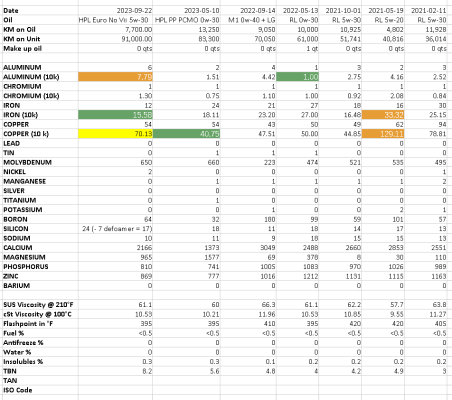Amsoil
says it is an issue with rings, huh maybe. Would a thicker oil make less dilution in this case? Maybe? Gas is so thin this just may be something unavoidable. Maybe injectors that atomize fuel more then oem? Maybe some injectoers need a good cleaning? sI-1?
GDI engines are good to a point, but they have their known issues.
The dealerships never tell anyone these things and make a fortune on service.
I've got an acquaintance who's a Service Manager at a Hyundai dealership, and the stories I'm told that happen behind the scenes in the shop because of the GDi engines... wow is all I can say.
I've had a few Hyundai's in my time; great cars and quick, but I had to use premium fuel, GDi fuel injector cleaner frequently, and shorten the OCI's because of their tendency to absorb the fuel in their oil.
** Taken from a published article regarding known/common GDi engine issues:
Fuel Dilution: Because the injectors are located in the combustion chamber, fuel spray can wash past the rings, down the far cylinder wall and into the oil sump, contaminating the oil and affecting its viscosity. This can cause issues such as increased wear of pistons, rings and cylinders, reduced protection against deposits, higher oil consumption and quicker oxidation.
Oil Vaporization: The higher temperatures and pressures in GDi engines can accelerate oil vaporization. Oil vapors passing through the cooler areas of the engine such as the intake valves, piston crown and catalytic system can lead to pooling and the formation of oil droplets. Because, unlike a port fuel injection engine, these droplets are not washed off by the fuel, they can coat and bake onto the valve causing performance issues.
Oil Evaporation: The higher temperatures in the crankcase can also cause some of the oil to evaporate, meaning that the fuel can become more concentrated. Much like fuel dilution, this impacts the oil’s viscosity, accelerating wear and tear of key components and reducing the oil’s service life.
Carbon Buildup: Again, because fuel no longer reaches and cleans the valves, this can result in a build-up of carbon on both the injectors and valves, restricting fuel delivery and air flow to the cylinders respectively. Over time, these deposits can cause performance issues such as reduced engine power and fuel economy.
Low-Speed Pre-Ignition: Known as LSPI for short, it typically occurs under low speed, high load conditions. LSPI is caused by fuel droplets that are released into the combustion chamber and ignited before the spark plug fires. This abnormal combustion event can result in higher engine pressures, leading to engine knock and potentially severe internal damage.
As these service issues can occur in as little as 3,000 miles, diagnosing and remedying them early is important. Failure to do so will not only affect the vehicle’s performance and fuel economy, but if left untreated for long enough, could also result in severe engine damage, requiring a timely and costly teardown to fix.


